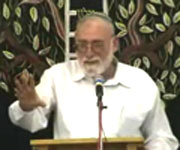Beit Midrash
- Shabbat and Holidays
- Sukkot
- The Spirit of the Holiday
- Sections
- Chassidish Stories and Great Rabbis
- Chassidish Stories
The Torah study is dedicatedin the memory of
Yaakov Ben Behora
That R' Simcha Bunim of Peshischa revealed himself as a Hasid during Sukkot of all times brings us to one of the important foundations of Hasidism: the service of God via our physical-material world. Hasidic doctrine rests upon the fundamental concept that "there is no place absent of Him." God's presence permeates existence. All man has to do is discover and reveal this presence. This explains why serving God via the physical-material world commands such a central place in Hasidic thought.
When man serves God on a physical plane, he enters a realm of being which conceals, as it were, the existence of the Almighty, and proceeds to uncover the divine dimension therein. This is the reason that the Hasidic movement, throughout its existence, made considerable use of elements in the surroundings, accepting the world as it is and not rejecting it because of its base material nature.
The abrupt transition which we undergo from the closing hours of Yom Kippur into the banging of the first nail of the Sukkah meshes well with this approach. Yom Kippur symbolizes God's transcendent nature, His distance from the material world. On Yom Kippur we disengage ourselves from material existence and enter a world which is completely spiritual. However, with the departure of Yom Kippur we seek this spiritual illumination within the physical world itself, for "there is no place absent of Him." The same nail which symbolizes our being grounded in reality also symbolizes the unveiling Yom Kippur's divine element in our mundane daily existence.
The Lubavitcher Rebbe relates to the cry, "God is the Lord!" which we proclaim seven times at the end of Yom Kippur. God's innefable name (YHVH) symbolizes His spiritual and transcendental dimension that has absolutely no interaction with physical existence. The name Elokim (Lord) symbolizes God's appearance within the world. The numerical value ("gematria") of the name Elokim is equivalent to the word "nature" ("ha-teva"). Hence, the latter is the sole name that appears throughout the Torah's account of creation.
When we proclaim at the end of the Yom Kippur service that "God is the Lord!" what we mean to say is that the very same unique spiritual reality we experienced on Yom Kippur must also be revealed in the material world - that which we will reenter immediately after Yom Kippur.
The story of R' Simcha Bunim's revelation is woven with the Hasidic foundations mentioned above. A feeling of great exaltation pervades the entire story. Hasidic worship was characterized by enormous rapture. The Hasidim considered it important to create a bond between the physical body and spiritual worship. Exaltation causes the physical body to become filled with energy and speed, making it a conduit for man's spiritual service. This is how a person finds the divine foundation within himself, his service, and his body, in the sense of "From my flesh I shall see God" (Job 19:26).
R' Simcha Bunim dances joyfully in his Sukkah. Hasidim made a point of dancing a lot, especially on festive occasions. We have discussed the idea of enlisting the physical body for the service of God, to uncover God Who reveals himself via the flesh of man. Dancing means employing the entire body, right down to the feet.
The feet generally symbolize the lowed, basest point in man's body, yet, when dancing, the feet rise up from the floor and receive the divine illumination which comes to a person while serving God according to Hasidism. All this ties in with an idea Hasidic Jews relate in the name of R' Simcha Bunim himself: The commandment to sit in the Sukkah is unique because it involves entering the Sukkah together with our clothes and shoes and all of the dirt that is on them. In other words, even the dirt on a person's dancing feet give voice to Godliness.
In this state of holy ecstasy, R' Simcha Bunim turns to kiss the walls and floor of the Sukkah. Apparently the walls were of wood and the floor of soil. The soil of Peshischa is not that of the Land of Israel, but despite this R' Simcha Bunim felt the need to kiss the walls and floor of the Sukkah. The walls are the physical structure of the Sukkah commandment, and the floor is the most material foundation upon which the Sukkah rests. We are once again brought back to the firm foundation of reality.
The loftiest of ideals must be bound to the most material of realities. R' Simcha Bunim sees the holy illumination in the walls and floor of the Sukkah. He sees more than just an bunch of boards erected on a dirt floor. He sees the illumination of "the shadow of faith" ("tzila d-mehimnutah"; see Zohar 3:103:1).

“… And Joy for Those with Straight Hearts”
Rabbi Shaul Yisraeli zt"l | Tishrei 12 5781
The Day The Music Died
Rabbi Yaakov Asher Sinclair | Tishrei 13 5782
Succot's Relief
Rabbi Berel Wein zt"l | Tishrei 9 5782




















